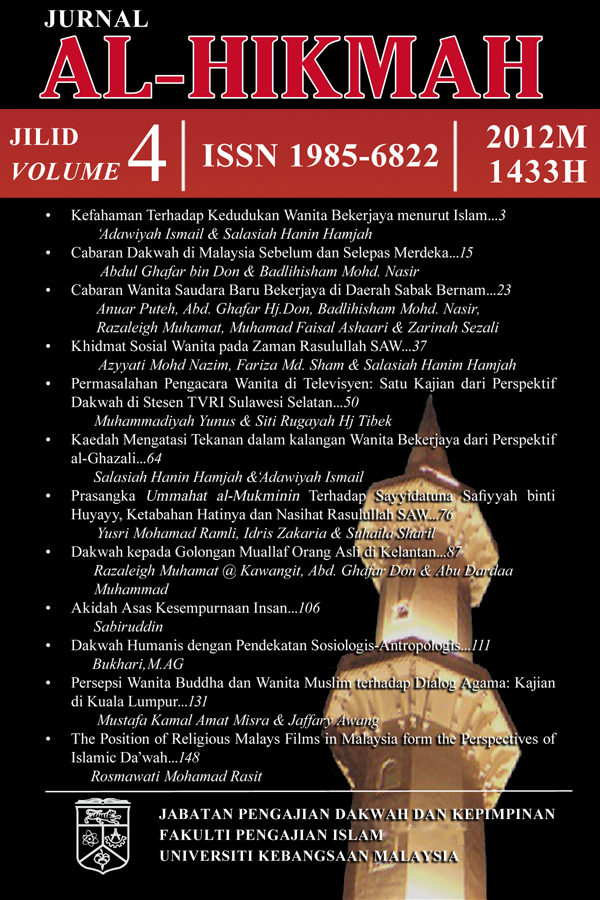PROBLEMS OF FEMALE PRESENTERS ON TELEVISION: A STUDY FROM A DA’WAH PERSPECTIVE AT TVRI SULAWESI SELATAN
Permasalahan Pengacara Wanita di Televisyen: Satu Kajian Dari Perspektif Dakwah di Stesen TVRI Sulawesi Selatan
Abstract
Television is a significant communication medium as it not only conveys information but also serves educational, entertainment, and social connecting functions. Today, television has become an essential part of modern life and is also an effective da’wah medium. This study addresses the issues faced by female presenters working in the television industry. The research employs a literature review method, observational analysis conducted by the author during their tenure as a television presenter at TVRI Sulawesi Selatan, and interviews with Dra. Nurdiyah, the Coordinator of TVRI Sulawesi Selatan. The study highlights issues such as unequal treatment of female presenters compared to their male counterparts, gender equality concerns, and adherence to religious directives for Muslim female presenters. It emphasizes the need for involvement from various stakeholders, including the Indonesian Broadcasting Commission (KPI) as a governmental body, scholars and community leaders, the chairpersons of TVRI, and families and the general public. The objectives of this study are to explore female involvement in the broadcasting industry, identify specific issues faced by female television presenters, and propose solutions from a da’wah perspective to benefit the field of knowledge.
References
Abdullah bin Wakil As-Syaikh. 2002. Salah Paham tentang Wanita. Penerbit Gema Insani Pers. Jakarta: Penerbit LP3Y Yogyakarta.
Abdullah, Muhammad. 2001. Segmentasi Gender dalam Fiqih Wanita Islam Tradisionla: Kajian Teks ‘Uqud Al-Lujjain Fi Huqquq Az-Zaujain. (Kasus di Pesantren ARIS Kaliwungu Kendal). Documentation. Fakultas Sastra. Diponegoro University, Institutional Repository e-mail:eprint@
Arkam, Liza Akmalia dan Retnaningsih. 2007. Interpersonal Communication Competency Differences between Men and Women Broadcasters. Jakarta: Gunadarma University. http://www.gunadarma.ac.id.
Ariefa Efianingrum dan Y. Ch. Nany Sutarini FIP.2008. Persepsi Masyarakatn terhadap Citra Perempuan dalam Iklan di Televisi. t.tp.
Daulay, Harmona. 2007. Perempuan dalam Kemelut Gender. Medan, Indonesia: USU Press, Art Design Publishing and printing.
Fadhlan. 2007. Islam, feminism, dan Konsep Kesetaraan Gender dalam Al-Quran. fadlanelhanif@gmail.com)
Khariri. 2009. Kesetaraan Gender dalam Perspektif Islam: Reinterpretasi fiqih wanita. Jurnal Studi Gender & Anak YINYANG. 4(1), 27-40. Pusat Studi Gender STAIN Purwokerto.
Mudaris, Hudan. 2009. Diskursus Kesetaraan Gender dalam perspektif Hukum Islam; menuju Relasi Laki-laki dan Perempuan yang Adil dan Setara. Jurnal Studi Gender & Anak YINYANG, 4(2), 27-40. Pusat Studi Gender STAIN Purwokerto.
Muhammad, Hasan Kiyai Haji. 2001. Fiqh Perempuan Refleksi Kiyai atas Wacana Agama dan Gender. Yogyakarta: PT. LKiS Pelangi Aksara.
Pane, Teddy Resmisari. 2011. 2004. Speak Out: Panduan Praktis dan Jitu memasuki Dunia Broadcasting dan Public Speaking. Jakarta.
Simanjuntak, Erlianti. 2011. Kemampuan Penyiar Berita Terhadap Citra LPP TVRI Medan (Studi Kualitatif tentang bagaimana Pengaruh Penyiar Berita terhadap Penyiar berita terhadap Citra LPP TVRI Medan). http://repository.usu.ac.id/handle/123456789/27843
Siregar, Ashadi. 2001. Menyingkap Media Penyiaran, Membaca Televisi Melihat Radio. Yogyakarta: Penerbit LP3Y.
Sudarta, Wayan. t.th. Konsep gender dan Pengarusutamaan Gender. Fakultas Pertanian Universitas Udayana.
Supriadi. 2011. Dampak Perubahan Organisasi Televisi Republik Indonesia Terhadap Kinerja Karyawan Dalam Hubungannya dengan Mutu Siaran TVRI Sulawesi Selatan.Makassar, Indonesia.
Yunus, Muhammadiyah. 2007. Jangan Terhipnotis Televisi. Makassar: Penerbit Komisi Penyiaran Indonesia.
Zulkiple Abdul Ghani. 2003. Islam Komunikasi dan Teknologi Maklumat. Kuala Lumpur: Utusan Publications & Distributors, Sdn. Bhd.
Authors retain copyright and grant the journal right of first publication with the work simultaneously licensed under a Creative Commons Attribution License (CC BY-SA 4.0) that allows others to share the work with an acknowledgement of the work's authorship and initial publication in this journal.








